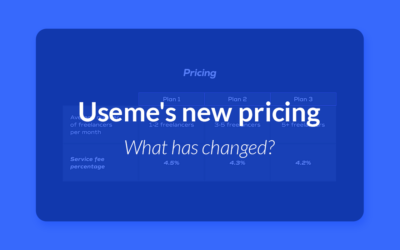Download our creative brief template
You can download our creative brief template in Word, or Google Docs formats, designed to guide you through creating a comprehensive brief.
This template includes all the elements to align your creative team or freelancer to the project goals and ensure an amazing creative outcome.
What’s inside the template?
Our creative brief template contains key sections to help you guide your creative project, including details about your target group, project objectives, brand book, and success metrics.
Inside, you will find:
- brief template Word, and Google Docs.
- a definition of each point and why you must complete it
- helpful questions to help you better complete the brief for a freelancer
- pro tips and real-life examples.
It ensures your freelancer or creative team has the right information for delivering exceptional creative work that aligns with your goals.
How to use the template
Using the creative brief template is simple. Fill in the sections based on your own research and specific project needs:
- Customize each section – tailor every section to your unique brand and project requirements, guiding the freelance writer or team with specific questions that help them better understand your expectations.
- Provide examples – add examples to illustrate the direction you want, like previous campaigns or creative brief examples that align with your brand voice and vision.
- Adapt for different freelancers – adjust each section based on the freelancer’s role. For example, provide a content style guide for copywriters, brand book links for graphic designers, or visual references for photographers.
- Collaborate and finalize – share the creative brief template.
How to write a brief for a freelancer
However, writing creative briefs can feel overwhelming if this is your first time. This is where a structured creative brief template becomes invaluable. Using a template, you can organize key elements like target audience, brand guidelines, and project objectives to guide your freelancer effectively.
In this blog post, you’ll learn how to write a creative brief that keeps everyone on the same page. You’ll discover the key elements in crafting creative briefs that deliver exceptional results.
Ready to dive into the world of creative briefs? Let’s start writing your creative brief to collaborate smoothly with your freelancer.
Understanding the creative brief
Let’s explore what a creative brief is and why it’s vital for your business projects.
What is a creative brief?
A creative brief is a document that outlines the project objectives, creative direction, and critical elements needed for your freelancer. It serves as a guide to ensure the creative project aligns with your business goals. It’s an essential step of the freelancer onboarding process.
Think of it as a blueprint that shapes the vision of your project, helping the team members stay on track.
When you write a creative brief, you’ll need to cover fundamental elements like:
- Target audience – define who your marketing creative will reach.
- Brand guidelines – ensure your brand voice and visual identity are maintained.
- Key messages – clearly articulate the project’s key messages.
- Project scope – determine the project’s purposes, deliverables, and assets.
Why is a creative brief important?
A good creative brief ensures you and the freelancer are on the same page to deliver a successful project. It minimizes the risk of scope creep and ensures that your project managers, internal teams, and freelancers have a shared understanding of the creative process.
With a solid creative brief, you can:
- Improve the way you manage freelancers – clarify timelines and objectives to ensure the team can track progress efficiently.
- Align creative direction – keep everyone focused on the same direction, minimizing revisions and delays.
- Effort success – establish key metrics to evaluate the deliverables, ensuring marketing assets meet your standards.
Investing time in writing creative briefs will help you produce more successful creative projects and enable your team to stay organized and aligned from start to finish.
Creating a good creative brief for freelancers
Crafting a creative brief sets the tone for a successful collaboration with your freelancer, creative team, and project manager. By understanding what to include and avoid, you can produce a clear, actionable, creative brief template that guides your freelancer toward excellent work while meeting project goals and staying within scope.
Let’s look at some key dos and don’ts to ensure your own creative brief is well-written, concise, and effective.
How do you write creative briefs?
To create a useful creative brief, make sure it:
- Clearly defines project objectives – your team must know the project’s purposes and how their creative work fits your broader marketing campaigns. Provide a clear project overview that sets expectations.
- Identifies key message – highlight messages that align with your brand voice and resonate with your target audience.
- Describes the target audience – including demographic and psychographic information, to ensure your creative marketing reaches the intended audience. This will help freelance writers craft the right creative collateral.
- Outlines the task scope – clearly states the scope to avoid scope creep and sets expectations around deliverables.
How not to write creative briefs?
Avoid these common pitfalls to ensure a well-crafted creative brief:
- Avoid vague instructions – broad or unclear guidelines can confuse your team. Provide detailed guidelines and clarify any technical terms to minimize miscommunication.
- Don’t be overwhelmed with information – your creative brief should be concise. Instead of writing a long document, focus on critical elements like the target audience, project objective, and deliverables.
- Don’t overlook competitive research – understanding the competitive scenery will help your freelancer deliver a marketing creative that stands out.
- Avoid neglecting timelines – establish deadlines for deliverables and final reviews to keep your creative project on track.
Following these dos and don’ts, your creative brief will serve as a clear, practical guide that ensures a victorious project from start to finish.
Essential elements of marketing creative briefs
Every creative brief requires specific fundamental elements to ensure it provides the necessary guidance for a marketing team and project manager.
These essential elements are necessary for your creative brief to have direction, leaving your team clear on the project’s goals. A well-structured creative brief can be just a few pages long but should thoroughly cover the target audience and the project’s key messaging.
Let’s break down these key factors so you can write a creative brief that’s detailed, comprehensive, and effective.
Target audience
Describing your target audience is crucial for shaping your creative project’s messaging.
Provide demographic details like age, gender, location, and income to ensure your team understands the audience’s basic characteristics.
Include psychographic information, such as interests, hobbies, values, and pain points.
This comprehensive description helps your team develop marketing collateral that resonates with your target audience. With these insights, you can write a creative brief that aligns with your audience’s needs, increasing the project’s chance of success.
Project & company background
To give the team a strong foundation, provide a concise overview of your company’s background and goals. Include the project title and company background section in just a few sentences to provide important details about your business and mission.
Highlight the project’s purposes to illustrate how this project will contribute to your brand’s overall marketing strategy.
Your brief should position the project within the competitive scenery, ensuring the direction is well-informed and consistent with your company’s identity.
Objectives
Clearly state the creative project’s objectives to align them with your marketing strategy. Are you trying to launch a new feature, increase brand awareness, or reach a new audience?
Ensure your objectives are specific, measurable, achievable, relevant, and time-bound (SMART). This will help your team understand the project’s plans and how to measure success.
When writing a creative brief, describe how the final deliverables will impact your brand and marketing campaigns, offering a clear vision to all stakeholders.
Scope
Clearly defining the project’s scope prevents confusion and helps your team deliver the right creative assets.
Describe the overall project overview, the project’s ideals, and the specific performance required. Highlight potential challenges impacting scope, like tight deadlines or ad campaign restrictions.
Setting these boundaries prevents scope creep, ensuring your team stays focused on creating effective deliverables. Ensure the project’s scope aligns with the project’s objective and direction.
Brand guidelines
Your creative brief should include a detailed brand book to maintain consistency in the final results.
Share your brand’s voice, visual identity, and key messaging to align the creative work with your marketing strategy. Provide your brand’s tone, colors, typography, and graphic design, helping the team understand what fits with your audience.
This ensures all creative projects embody your brand’s identity, strengthening brand recognition across marketing campaigns.
Key message
Craft the project’s key message in just a few sentences to provide a clear, compelling structure.
Your messages should emphasize the main ideas you want your target audience to remember. They should also align with your marketing materials and campaign goals.
Key messages guide the direction, and internal teams can deliver consistent messages. Be specific and intentional!
Competitive landscape
Provide insights into the competitive landscape to help your project stand out.
Analyze your key competitors, identifying their strengths and weaknesses, marketing strategies, and positioning in the market. Highlight opportunities and challenges that your brand faces in comparison to theirs.
This information helps your team understand where your brand fits and how to differentiate your creative assets. This view of your competition can refine your project’s key messages and guide your creative brief template.
Metrics of success
Identify key benchmarks and metrics to measure the project’s success and ensure your team is on the same page.
Define specific metrics for creative projects, such as conversion rates, engagement levels, and brand awareness.
Make sure these metrics align with your project’s objectives and marketing goals. This allows you to monitor the process more effectively with measurable benchmarks and data-driven results. It also enables you to refine your creative brief examples for future projects.
Budget and timeline
Provide a detailed overview of the project’s budget and timeline to avoid scope creep and ensure a realistic brief.
Break down the budget for each creative asset, accounting for marketing collateral, social media assets, and advertising campaigns. Specify critical project milestones and deadlines for delivering initial drafts, revisions, and final deliverables.
This allows you to plan project management workflows effectively. As a result, everyone will be focused on completing the project on time and within budget.
Benchmarks
Establishing benchmarks is essential for evaluating your project’s progress and aligning your team with its objectives.
You can start by identifying specific, measurable milestones that will help you gauge whether your marketing team is on track to meet project goals. These could include conversion rates, engagement levels, and customer feedback.
Use these benchmarks to provide feedback throughout the creative process, helping freelancers or your internal team refine their work as the project unfolds.
Setting clear benchmarks upfront ensures you have a reliable framework to measure success and guide your direction toward a victorious project.
Summary
Writing a creative brief is crucial to achieving effective collaboration with freelancers.
Following this guide and our creative brief template, you can organize the project overview, set clear expectations, and identify critical success metrics. These tools allow you to streamline your direction and ensure project outcomes align with your marketing strategy.
So, take your briefs to the next level. Download our free creative brief example today and start your journey toward successful projects with freelancers who understand your vision.



